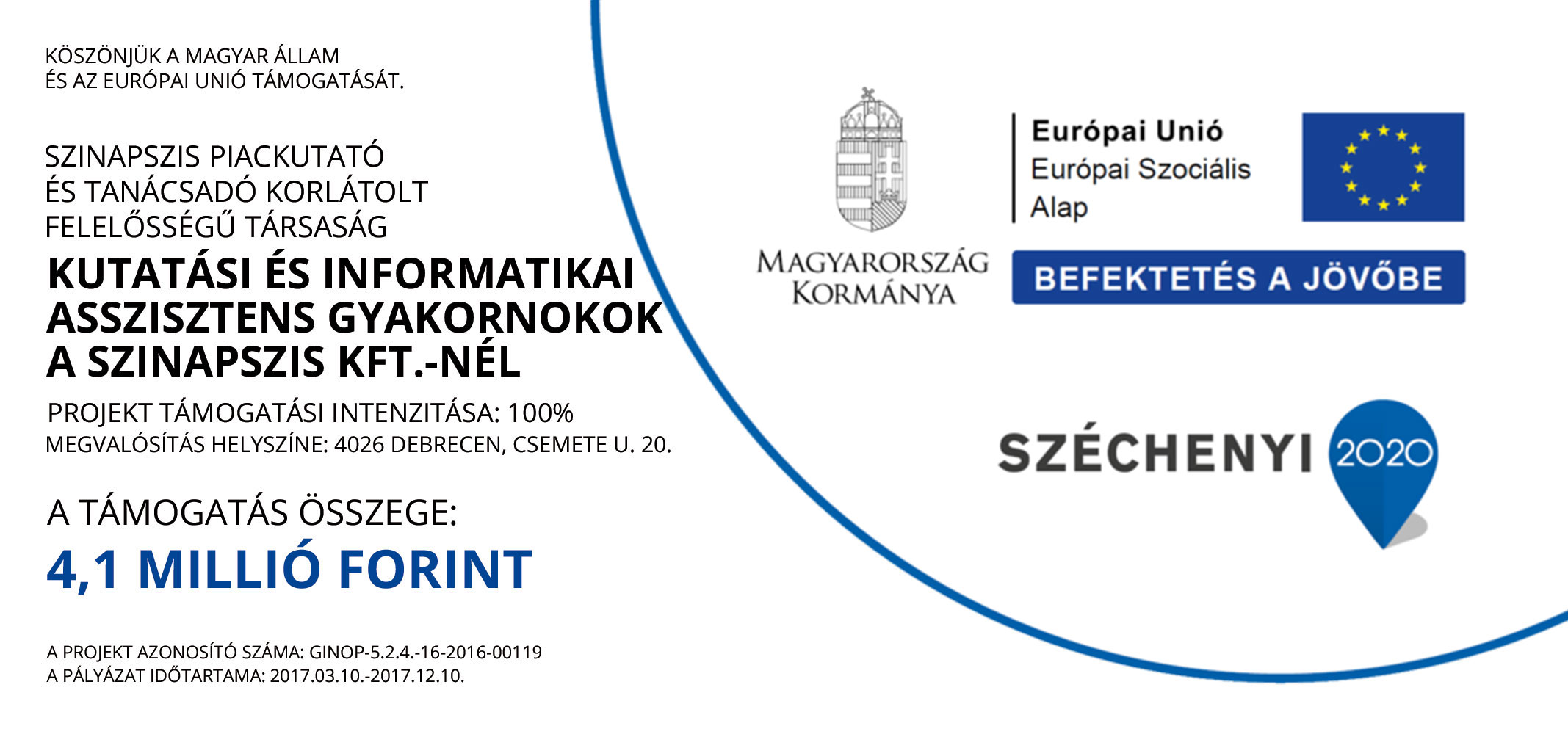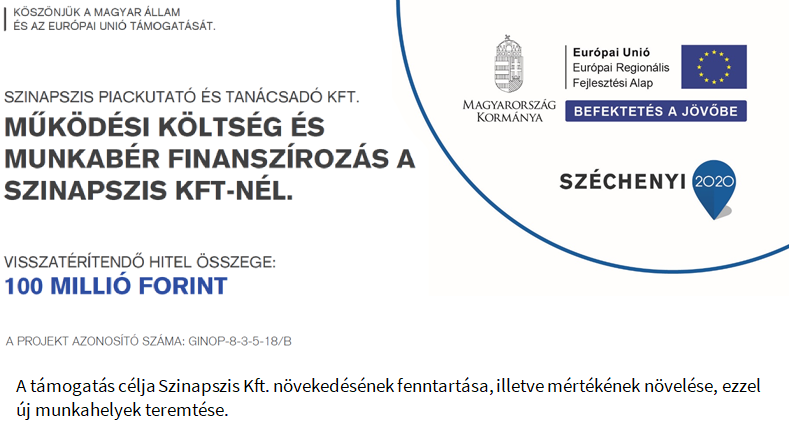Dr. András Szabó CEO on Pharma Boardroom
- 2020-03-02 12:07:00
- Kutatás
.jpg)
Dr. András Szabó, CEO of Szinapszis, a Hungarian market research and consulting agency specialized in the health industry, offers his expert insights on the key challenges and trends shaping the country’s pharma and healthcare ecosystem. Furthermore, Szabó highlights the offering Szinapszis can deliver as a partner of choice to both the entire healthcare industry value chain and authorities as an experienced solution-driven consultant in the local market.
Please begin by introducing Szinapszis and the key activities of the company.
Szinapszis was established in 1998 after I completed my studies as a medical doctor and later as a juristic doctor. Szinapszis is a market research company that is part of a larger group that also includes health media and communication, IT service provider, and software development companies. Our core competence is within the pharma industry.
Our first main activity is market research and consulting. Through these projects, we offer a deep insight into most areas of the Hungarian pharmaceutical and healthcare market. This includes providing pharma companies with market information, research, sales effectiveness analysis, etc. On the other hand, we also work with health-related companies such as food supplements and medical device players. Third, our clients also include healthcare providers, being both the private and public healthcare sectors. Finally, we often provide health politics consultation through collaborating with state-level consulting agencies or even directly to government authorities. Currently, our biggest market segment is the private healthcare sector which is rapidly developing here in Hungary.
How is Szinapszis differentiated from other data and marketing consultancies in Hungary?
IQVIA, for example, is primarily focused on data selling. While they do have a market research and consulting service aspect, they have limited capabilities here in Hungary. As Szinapszis is a truly Hungarian company with over two decades of experience, we have an unmatched level of expertise in the country. IQVIA even uses our field work services to collect data.
Many of our employees have been working in the healthcare industry for over 10 years. While many multinational consultancies have to manage high turnover rates, Szinapszis has been built up by dedicated professionals. This is why both local Hungarian and MNC companies find value in our services.
Furthermore, given my education as a medical doctor, we are well accepted on both the client-side and the stakeholders we meet for our research. In the same vein, keeping a strong connection to Hungary’s medical universities is essential to our operations. All in all, we are very integrated and recognized within the local healthcare ecosystem.
What would you identify to be the major trends having the greatest impact on the Hungarian healthcare ecosystem?
The first major trend would be the advancement of the private healthcare sector in Hungary. All countries have limited resources to pay for healthcare solutions and in Hungary, high levels of innovative and fast treatment have always been available through the private sector. This is not only for patients with high socioeconomic status, but more and more middle-class patients have made this shift. In the future, there will be a definitive two level-healthcare system, but so far there is no regulation for social security to be applied in private institutions. So far, the out-of-pocket private market size stands at HUF 300 billion with the top 15 players holding more than 30 percent of market share.
The next major trend has been the successful implementation of an electronic healthcare service platform (EESZT) over the previous year. All healthcare institutions, including public and private, must join the system before January 2020. Therefore, all patient-doctor interactions, prescription data, diagnosis, etc. will be collected in this state-run database. This will be a major tool in tracking patient pathways and determining the costs of care in each segment. The question remains who will be analyzing this data and what the final results will be. Regardless, by closely monitoring the healthcare system, the authorities will be able to see where costs are coming from and identify solutions to improve spending and efficacy.
Patient adherence is very low in Hungary which is a major challenge in the healthcare system if medicine and treatment regimens are not followed as they should be. Furthermore, the Hungarian population is notorious for bad health habits such as high rates of smoking, alcohol consumption, and poor diet. These factors together create added burden for Hungary’s healthcare system by increasing medical needs and reducing efficiencies. Therefore, patient education is a major hurdle that must be addressed in the country.
Lastly, in line with these trends we see a growing significance of digitalization in healthcare in Hungary. For example, ten years ago we launched an online medical portal, WebBeteg, similar to WebMD in the US. WebBeteg is currently ranked within the top 25 web portals in Hungary and has around 150,000 unique visitors per day. These validated articles are written by medical doctors and cover themes such as lifestyle, diseases, diagnosis, treatments, etc. Thirty-five percent of the population visits healthcare portals like WebBeteg and we will continue to see more patients and health professionals turning to online resources to manage health and better understand treatments.
The Budapest Business Journal reported that there are 635 vacancies for general practitioners and dental surgeons. What factors are contributing to this shortage?
It is true that around 600 medical practitioner positions are empty in Hungary, primarily in small villages. There is a special financial package for GPs in the country based on several factors such as how many patients they have and where they are located among other considerations. These practices are empty because it is very challenging to motivate practitioners to work in these locations while making lower incomes – the allocation of resources in Hungary is unequal. However, this is not to say that there are patients without doctors. Either they travel to neighboring villages or the doctors come to them.
It is important to note that the demographics of GPs are quite aged, with the average being 57 years old. Currently, there is no generational shift in Hungary and this statistic is continuing to increase each year.
What makes Hungary an attractive pharmaceutical market?
Despite the country’s smaller population, the drug consumption per patient is very high compared to other markets in Europe. Additionally, Hungary has a very strong tradition in the pharmacology field. We have had four very large pharma manufacturers historically being Gedeon Richter, Egis (now a fully owned subsidiary of Servier Group), Biogal (now Teva), and Chinoin (now Sanofi). These large manufacturing and logistics centers have positioned Hungary as a pharmaceutical hub in the region. Moreover, these capabilities have resulted in innovation being brought to the country which is also incentivized and supported by the government. One example being Gedeon Richter who is developing value-added products like biosimilars in the country.
Regarding sales and marketing, Hungary is also seen as a pilot country for new strategies as it is a small yet well-developed market. For instance, digitalization has been implemented quite heavily in the past years and pharma companies have already begun to communicate with health stakeholders digitally. One reason for this phenomenon is the very high tax on medical sales representatives in the country. For each sales representative employed, a company must pay a fee of HUF 10 million per year. The aim of this regulation was to reduce the number of face to face visits with the doctors in an attempt to reduce drug consumption and sales while promoting multichannel communication.
What are the primary challenges being faced by the pharmaceutical industry players in Hungary?
On one hand, the biggest challenge the industry faces is that the market will not continue its growth trajectory in the coming years. About five years ago the government initiated a very strong generics program and Hungary has already become a generics market. Manufacturers had to reduce their prices significantly which has enabled the state to maintain the reimbursement level at a fixed budget. In previous years, the budget was increasing rapidly and unsustainably, therefore the government took this step to control spending and consequently has also frozen the reimbursement of new innovative products. This has delayed many of the innovative drugs which have been developed in recent years from launching in Hungary.
What solution do you see as the most critical to ensuring success within the current condition of the Hungarian market?
Pharmaceutical companies should not only be drug sellers but service providers. Being a partner not only to patients and doctors but health authorities as well as an essential shift that is necessary for today’s healthcare environment. Patient centricity is a major topic of discussion in the industry but there are still very few concrete steps being taken in this direction. Establishing initiatives such as risk-sharing agreements with the government or programs to improve patient education and adherence are all tangible ways for the industry to embrace this trend and secure their margins.
How is Szinapszis positioned to be a partner for the healthcare industry in navigating the Hungarian market?
We aim to demonstrate to all the healthcare players on the market, especially the pharmaceutical companies, how consumers in Hungary are changing. We are also working with the government as consultants in the same vein, but they are a bit more advanced when it comes to embracing trends like digitalization. Pharma decision-makers are sometimes far behind consumers and how they should communicate with patients. Therefore, we in Szinapszis are trying to accelerate and help the industry understand these changes and adopt best-practices.
On the one hand, we offer our clients data through information consultancy while simultaneously creating communication solutions and showing them the most efficient channels and methods to utilize. Our biggest challenge is to convince the pharma executives in Hungary that the market and consumers here are more advanced than they may realize. Although patient education may be a challenge, health literacy is continuously improving, and even older generations of healthcare professionals are using more and more digital tools.
What would you say that healthcare and pharma stakeholders in Hungary are the proudest of?
The first would be Hungary’s electronic health record system. We have been very successful in its implementation and only a few other countries in Europe have achieved the level of comprehensiveness as Hungary. For the upcoming years, the EESZT offers the biggest opportunity to reorganize the Hungarian healthcare system.
Additionally, the Hungarian medical universities are world-class and have strong international connections around the world. Between the strong tradition of pharmaceutical manufacturers, unique universities, and skilled researchers, many technical innovations are coming out of Hungary. We see more and more startups and success stories in areas like medical devices and health IT.
Source: https://pharmaboardroom.com/interviews/andras-szabo-ceo-szinapszis-hungary/















